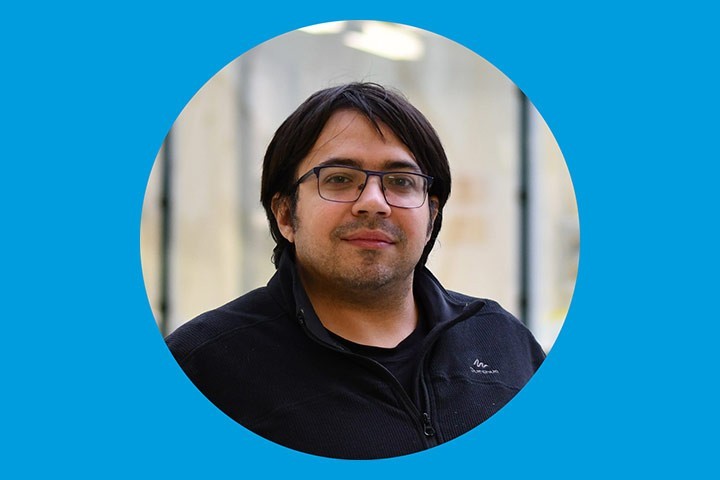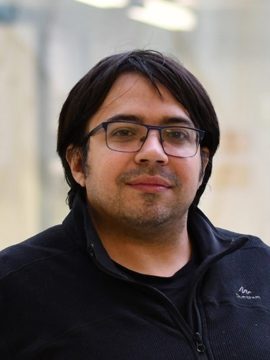
Interview: Sergio Hernandez Diaz

Sandra Soukup’s team (“Molecular mechanisms of synaptopathies“) was created in 2018 with a Junior Team Leader chair of the Neurocampusprogram funded by the Région Nouvelle-Aquitaine. We met Sergio Hernandez Diaz, who’s been a post-doc in the team from the beginning.
Bordeaux Neurocampus: What are the goals of your team?
Sergio Hernandez Diaz: The main aim of the lab is to understand how previously healthy neurons start to die. To better understand the early onset of neurodegeneration, we focus at the level of the synapse, the communication center of the neurons, because synaptic dysfunction often precede neuronal loss in neurodegenerative diseases.
To investigate this topic, we use Drosophila as a model organism and focus on how different molecular mechanisms of homeostasis are locally controlled at the synapse. One of these mechanisms is autophagy, a self-devouring process that can degrade defective proteins and organelles. An adequate balance of autophagy is critical for neuronal and synapse survival and this is why we are interested in the interplay between autophagy, synapses and neurodegenerative diseases.
You work with drosophilae flies. What are their particularities ?
The scientific name of the specie we use in the lab is Drosophila melanogaster. I love doing research “in vivo” using our flies because this specie has a powerful genetics toolbox (for example, we can easily decide where and when we express a protein or “switch-off” a gene), a lesser complex genome, very low comparative costs and shorter lifespan than other animal models. This last particularity is interesting because we can get “old” flies in few weeks.
General public is amazed when we explain that, besides the obvious differences between flies and humans, many fundamental biological processes are very similar. Talking about pathologies, nearly 75% of the genes that cause diseases in humans are conserved in flies. With these facts, it is easier to understand why the fly is such a successful model to study not only fundamental biological processes, like development, memory/learning and brain homeostasis but also pathological events like neurodegeneration and synaptophaties.
What about you? Could you tell us what you did before coming to Bordeaux ?
I studied Biology at the University Complutense of Madrid, the city where I come from. After this I completed a master in business and administration of biotechnological companies and after an internship in the biotechnological sector I started my PhD. at the CIC-Biogune (Bilbao), where I studied cell adhesion and spreading under the supervision of James D. Sutherland.
After my PhD I continued my investigations in Heidelberg (Bioquant), Strasbourg (CNRS UPR9022) and Leuven (VIB and KU-Leuven). During my career I have used several models (cells, yeast and Drosophila) and techniques to understand fundamental questions in cell adhesion, innate immune response and brain function.
After these experiences with neurobiology, I was happy to settle in Bordeaux, and join such a dynamic neuroscience community ! From a personal point of view, Bordeaux is also a very welcome and fantastic city, with many interesting activities nearby (e.g. visiting the caves in the area of Les Eyzies-de-Tayac-Sireuil is a must).
It the last months, new people joined the team. Can you introduce them to us?
Yes, new people joined us, Sandra Soukup and me, and that is great!
The first person who joint us was Patrick Main. Patrick was born in Auckland, New Zealand and after a countryside childhood, moved to Palmerston North to study at Massey University. He completed a PhD focusing on Drosophila behavior and neurological development. But unfortunatly he just left us due to family reasons. However, we will host a new postdoc starting from november, Carla Montecinos who obtained her PhD from the University Bordeaux and the Pontifica Universidad Catolica de Chile under the supervision of Daniel Choquet and Nibaldo Inestrosa respectively. We are very happy to welcome her and I am confident that she can use her expertise in advance microscopy and wnt pathway in my team to answer long-standing question in our field.
Our other post-doctoral fellow is Saurav Ghimire. He was born in a small village in the western part of Nepal. He did his undergraduate in Bachelors of Pharmaceutical Sciences from Nepal and then moved to South Korea to do Masters in Pharmacology. He finished his PhD in Molecular Genetics from the University of Glasgow.
Last December we also welcomed Irene Sanchez, who came from the beautiful city of Granada to pursue her PhD with us. Irene studied biochemistry in her hometown (as there was no specialization in neuroscience) and performed her master thesis in UK. Lucky for us, she is extremely interested in neurobiology and she decided to join us here in Bordeaux.
Finally, our group has grown even further with the arrival of Marthiale Ngombe, who is therefore the only French in our team. While studying her master in Neuroscience at the University of Bordeaux she joined us to help us with the Drosophila housing as zootechnician. She is interested in brain pathophysiology, in particular in how addiction can shape brain function.
More details
Last update 10/09/20
